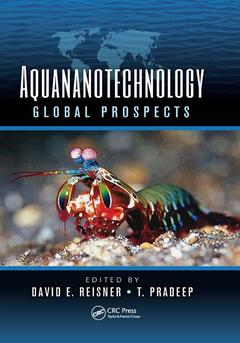Aquananotechnology Global Prospects
Coordonnateurs : Reisner David E., Pradeep T.

The world?s fresh water supplies are dwindling rapidly?even wastewater is now considered an asset. By 2025, most of the world's population will be facing serious water stresses and shortages. Aquananotechnology: Global Prospects breaks new ground with its informative and innovative introduction of the application of nanotechnology to the remediation of contaminated water for drinking and industrial use. It provides a comprehensive overview, from a global perspective, of the latest research and developments in the use of nanotechnology for water purification and desalination methods.
The book also covers approaches to remediation such as high surface area nanoscale media for adsorption of toxic species, UV treatment of pathogens, and regeneration of saturated media with applications in municipal water supplies, produced water from fracking, ballast water, and more. It also discusses membranes, desalination, sensing, engineered polymers, magnetic nanomaterials, electrospun nanofibers, photocatalysis, endocrine disruptors, and Al13 clusters. It explores physics-based phenomena such as subcritical water and cavitation-induced sonoluminescence, and fog harvesting.
With contributions from experts in developed and developing countries, including those with severe contamination, such as China, India, and Pakistan, the book?s content spans a wide range of the subject areas that fall under the aquananotechnology banner, either squarely or tangentially. The book strongly emphasizes sorption media, with broad application to a myriad of contaminants?both geogenic and anthropogenic?keeping in mind that it is not enough for water to be potable, it must also be palatable.
Bimodal UV-Assisted Nano-TiO2 Catalyst – Crumb-Rubber Device for Treatment of Contaminated Water. Hierarchical Carbon and Hydrogels for Sensing, Remediation in Drinking Water, and Aquaculture Drug Delivery. Use of Nanomaterials in Water Remediation by Subcritical Water Process. Reduction of Priority Pollutants by Nanoscale Zerovalent Iron in Subsurface Environments. Nanotoxicity: Aquatic Organisms and Ecosystems. SonoPhotoCatalytic Cavitation (SPCC) in Water Treatment. Bilge and Ballast Water Treatment Using Nanotechnology. Nanoengineered Organosilica Materials for the Treatment of Produced Water. Arsenic Removal Metrics that Commercialized the Drinking Water Market. Commercialization of Nano from Water Sensors to Membranes. Nano-Photocatalytic Materials for Environmental Applications. Engineered Polymers and Organic-Inorganic Hybrids as Antimicrobial Materials for Water Disinfection. Key Water Treatment Technologies and Their Use by Several Industrial Segments and Future Potential for Nanotechnology. Iron-based Magnetic Nanomaterials in Wastewater Treatment. Sustainable Clean Water: Closing the Cycle. Thin Film Nanocomposite Reverse Osmosis Membranes. Technological Developments in Water Defluoridation. Nanotechnology Tunneling in the Environmental Kuznets Curve (EKC): Nano Zerovalent Iron for Underground Water Remediation. Engineered Nanomaterials for Groundwater Defluoridation. Advances in Nanostructured Polymers and Membranes for Removal of Heavy Metals in Water. Point-of-Drinking Water Purification Innovation: The Water Initiative. WaterHealth International: Decentralized Systems Provide Sustainable Drinking Water. Electrospun Nanofibers in Water Purification. Light Activated Nanotechnology for Drinking Water Purification. Modified TiO2-based Photocatalytic Systems for the Removal of Emerging Contaminants from Water. Noble Metal Nanosystems for Drinking Water Purification: from Nanoparticles to Clusters. Water Desalination: Emerging and Existing Technologies. Challenges and Opportunities for Nanotechnology in the Energy-Water Nexus. Nanotechnology in Passive Atmospheric Water Capture. Evaluation of a Zinc Clinoptilolite (ZZ®) for Drinking water Treatment. Phosphorous Removal and Recovery Using Nanotechnology. Nanomaterials Persuasive in Long History of Pursuing Perchlorates. Stormwater Runoff Treatment Using. Bioswales Augmented with Advanced Nanoengineered Materials. Graphene: Applications in Environmental Remediation and Sensing. A quantitative high-throughput assay for detection of biologically active endocrine-disrupting chemicals in water. Novel Carbon-based Nano-Adsorbents for Water Purification. Engineered Nanomaterials for Landfill Leachate Treatment in the Humid Tropics: the Sri Lankan Perspective. Al13-Cluster Nanoflocculants for Remediation of DOCs and Colloidal Particles in Water. GE Water Provides Nanotech Product Solutions.
David E. Reisner, PhD, is a well-known early pioneer and entrepreneur in the burgeoning field of nanotechnology, having cofounded in 1996 two nanotech companies in Connecticut, Inframat® and US Nanocorp®. For nearly 15 years, he was CEO of both companies since founding, which were recognized in Y2002–Y2005 for their fast revenue growth as Deloitte & Touche Connecticut Technology Fast50 Award recipients. In 2004, The Nano Group Inc. was formed as a parent holding company for investment. Reisner and cofounders were featured in Forbes magazine in 2004.
David has more than 175 publications and is an inventor on 10 issued patents. He is the editor for the Bionanotechnology sections of both the third edition of The BioMedical Engineering Handbook (CRC Press) and the Handbook of Research on Biomedical Engineering Education and Advanced Bioengineering Learning (IGI Global). He is editor of Bionanotechnology: Global Prospects (CRC Press) and Bionanotechnology II: Global Prospects (CRC Press). He has written articles on the business of nanotechnology in Nanotechnology Law & Business as well as the Chinese publication Science & Culture Review.David served a 3-year term as a Technology Pioneer for the World Economic Forum and was a panelist at the 2004 Annual Meeting in Davos. David has served on the Board of the Connecticut Venture Group and was Chairman of the Board of the Connecticut Technology Council from 2005 to 2009. He was a NASA NanoTech Briefs Nano50 awardee in 2006. For his efforts in the field of medical implantable devices, he won the first annual BEACON award for Medical Technology in 2004. He is a member of the Connecticut Academy of Science and Engineering.
David is a 1978 University Honors graduate from Wesleyan University and received his PhD from Massachusetts Institute of Technology in 1983 in the field of chemical physics. An avid hiker, he summited Kilimanjaro in 19
Date de parution : 11-2017
17.8x25.4 cm
Date de parution : 11-2014
Ouvrage de 863 p.
17.8x25.4 cm
Thèmes d’Aquananotechnology :
Mots-clés :
Pe Rc; UF Membrane; reverse; Microbial Fuel Cell; osmosis; MMT; water; RO Membrane; treatment; American Chemical Society; carbon; Advanced Oxidation Process; nanotubes; Uoride Concentration; activated; Capacitive Deionization; alumina; Water Purication Systems; membrane; Photocatalytic Activity; distillation; NF Membrane; Ag NPs; Adsorption Capacity; Photocatalytic Reactors; Forward Osmosis; Fluoride Adsorption; SiO2 NPs; Magnetic Chitosan Particles; Photocatalytic Degradation; IONP; Heterogeneous Photocatalysis; Iron Nanoparticles; Maximum Adsorption Capacity; Water Remediation



